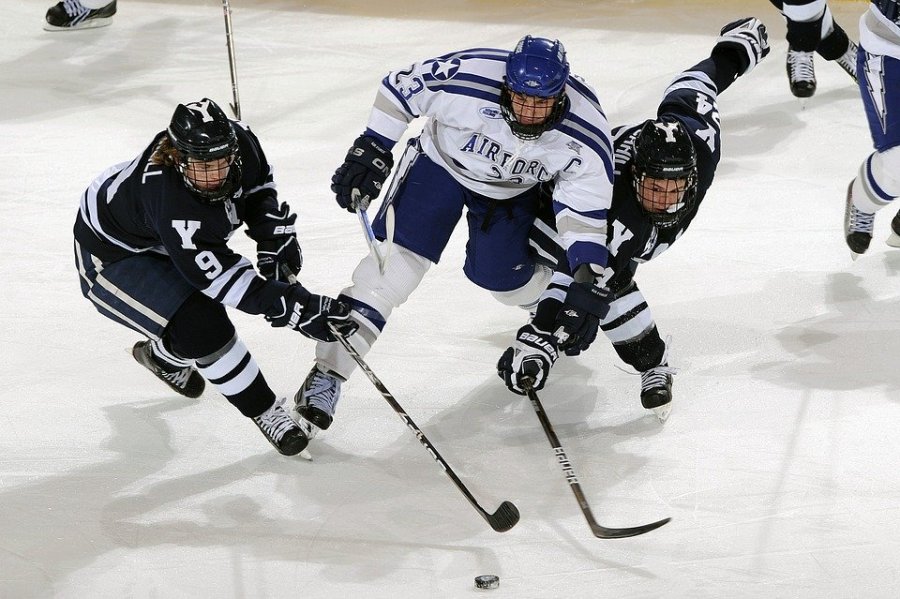How Many Periods Are in a Hockey Game?

Hockey has been a favorite game of sports fans since the late 1800s. The game is played on ice between two teams, and the winner is determined by the team that scores the most goals. This winter sport is popular in Canada, the cold, northern states of the United States and many other countries. In the U.S., there are professional teams in states throughout the country.
How Many Periods Are in a Hockey Game?
The game of hockey consists of three periods. After the first and second periods, there is an intermission which allows a break for the players and the ice rink to be resurfaced. This break usually lasts less than 20 minutes.
How Long Are Periods in a Hockey Game?
Both professional and college hockey periods consist of 20 minutes each. Professional hockey leagues get a 17-minute intermission after the first and second periods, whereas college teams get a 15-minute intermission between periods. Most high school hockey periods are also 15 minutes long.
How Many Players Are on a Hockey Team?
The total number of hockey players on a team varies, but the number of players on the ice for each team during normal play is six players. These players consist of the following positions: Goaltender, a center, two forwards ― usually called a right winger and a left winger ― and two defensemen.
History of Hockey
The first indoor ice hockey game in the record books was played in 1875. The game is said to have started as a variation of other games such as field hockey and lacrosse. The sport originated and was popular in Canada.
At the end of each professional hockey season in the National Hockey League (NHL), the two top teams play in a series of championship games to earn the award of the Stanley cup. This cup originated in 1892 when it was donated by Frederick Arthur, Lord Stanley of Preston. The first year the Stanley Cup was awarded to the champion of the NHL was in 1926.
Basic Rules of Hockey
In the NHL, the objective of the game of hockey is to score points by shooting a black, rubber puck into a net. The team with the most goals at the end of the game is deemed the winner. If the game is tied at the end of regulation play, a sudden-death overtime is played. The clock is set to a 5-minute period, but the first team to score wins the game.
Hockey games in the NHL are officiated by four officials, which include two linesmen and two referees. The purpose of the officials is to monitor the game for penalties, scoring, and other calls, such as icing and offsides.
The game of hockey begins with a faceoff. All of the players, except the goaltenders, gather around the center circle of the ice. The center positions face off against each other when the referee drops the puck. A faceoff happens after each goal is scored and when offsides and icing are called.
Offsides is called if a player that is not controlling the puck crosses the line into the offensive zone before the puck does. An official blows the whistle for icing when a player shoots the puck across the other team’s goal line from its side of the red line at center ice.
A penalty occurs when players foul another player illegally. Some examples of this are tripping, fighting, slashing, and high sticking. Players are sent to the penalty box, usually for a length of 2 minutes ― sometimes more ― depending on the severity of the penalty.
Other Facts About the Game of Hockey
The game of hockey is fast-moving with players continuously skating up and down the ice rink. Therefore, players switch their five-player line often with other players on the bench. The time that the players are on the ice is called a shift.
A standard size ice rink in the NHL measures about 85 feet wide and 200 feet long. This size varies on international rinks, which are usually about 184 to 200 feet long and 85 to 98 feet wide.
When a member of a team gets called with a penalty, their team skates shorthanded, and the other team is considered to be on a power play. The team on the power play skates with five skaters and a goalie while the other only has four skaters and a goalie. If the team that has more players scores a goal, it is known as a power-play goal. If the team with fewer players on ice scores, it is called a shorthanded goal.
A hockey team can pull their goalie off the ice to add another player among the forwards and defensemen. This situation usually happens during power plays or at the end of a game when a team that is losing wants extra manpower to try to score a goal.





